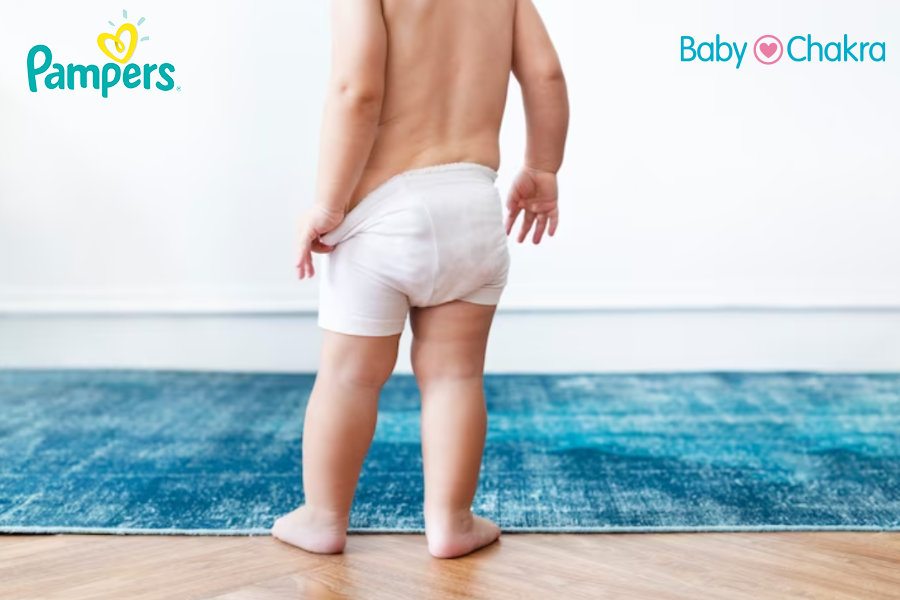
11 Reasons For Diaper Rashes In Babies And How To Prevent Them
24 Apr 2023 | 12 min Read
Manisha Pradhan
Author | 1053 Articles
Watching your little one grow and develop is a magical experience. But let’s face it, dealing with diaper rash is not so magical. It can be frustrating and painful for both you and your baby.
Diaper rashes in babies can be a common problem and there are certain factors that contribute to it. We’ve listed the 11 most common reasons that cause diaper rashes in babies and the practical way Pampers Premium Care Diapers can help keep your baby’s skin healthy and rash-free.
11 Most Common Reasons That Cause Diaper Rash In Babies
1. Diaper Size

One of the main reasons for diaper rash is the wrong diaper size. Choosing the wrong diaper size can contribute to the development of diaper rashes in babies and young children. If a diaper is too small or too tight, it can cause friction and rub against the skin, leading to irritation and inflammation. Similarly, if a diaper is too large or loose, it can cause leakage, which can result in prolonged exposure to moisture and urine or faeces, leading to diaper rash.
When choosing a diaper size, it is important to consider the baby’s weight and age, as well as the fit of the diaper. A properly fitting diaper like the Pampers Premium Care Diapers that are available in a range of sizes will ensure a snug and comfortable fit for your baby.
Plus, they are absorbent and prevent leakage, and do not cause rubbing or irritation.
2. Wetness
The most common cause of diaper rash is wetness. When a baby wears a wet or dirty diaper for a prolonged period of time, the skin in the diaper area can become irritated and inflamed. This is because moisture can cause the skin to soften and become more susceptible to damage from friction or rubbing against the diaper. Wetness can also promote the growth of bacteria and fungi, which can further irritate the skin and lead to infection.
Additionally, exposure to urine and faeces can cause irritation and chemical burns on the skin, particularly if the baby’s skin is sensitive or if there is prolonged exposure.
To help prevent diaper rash, it is important to choose diapers that are absorbent and well-fitting can help to reduce the risk of diaper rash. With the Pampers Premium Care Diapers, that has up to 12 hours of leak lock, you don’t need to worry about regularly checking the diaper to make sure it is not too wet or soiled as they also come with a wetness indicator to let you know when it’s time to change it.
3. Friction

Friction is another factor that can contribute to the development of diaper rashes in babies and young children. When a diaper rubs against the skin, it can cause irritation, inflammation, and redness in the affected area. This is particularly true if the skin is already moist or wet, as moisture can soften the skin and make it more susceptible to damage from friction. Friction can occur in several ways when a baby is wearing a diaper.
For example, the diaper may rub against the skin when it is too tight, too loose, or not positioned correctly. Additionally, when a baby is moving around or crawling, the friction caused by the diaper rubbing against the skin can exacerbate any existing irritation and contribute to the development of diaper rash.
To help reduce the risk of friction-related diaper rash, it is important to choose a well-fitting diaper that has a soft and flexible design and minimises friction, reducing the risk of a diaper rash. Choose diapers like the Pampers Premium Care Diapers that contain aloe vera lotion which helps to soothe the babies skin and also reduces friction.
4. Allergies
Allergies can also contribute to the development of diaper rashes in babies and young children. When the skin in the diaper area comes into contact with an allergen, it can become red, itchy, and inflamed. This can lead to the development of a rash, which may be accompanied by other symptoms such as blisters, hives, or bumps.
Common allergens that can cause diaper rash include fragrances, dyes, preservatives, and latex. These substances can be found in diapers, wipes, creams, lotions, and other products that come into contact with the skin in the diaper area. To help prevent allergy-related diaper rash, it is important to avoid using products that contain known allergens or irritants.
Parents should read the labels of all products carefully and look for hypoallergenic or fragrance-free options when possible.
5. Diet
Diet can also play a role in the development of diaper rashes in babies and young children. Certain foods or drinks that are consumed by the baby or the breastfeeding mother can cause diaper rash or exacerbate an existing rash.
For example, acidic or spicy foods can irritate the skin in the diaper area, particularly if the baby has loose stools or diarrhoea. Additionally, breastfed babies may experience diaper rash if the mother eats certain foods that the baby is sensitive to, such as cow’s milk, soy, wheat, or eggs. To help prevent diet-related diaper rash, it is important to identify and avoid any foods or drinks that may be causing or exacerbating the rash.
You should also make sure that the baby is getting enough fluids to prevent dehydration, which can also contribute to diaper rash. If diet-related diaper rash does occur, it is important to address the underlying cause by modifying the baby’s or the breastfeeding mother’s diet.
6. Illnesses
Illnesses can also contribute to the development of diaper rashes in babies and young children. When a baby is sick, their immune system may be compromised, which can make them more susceptible to skin irritations and infections.
Certain illnesses can also cause diarrhoea, which can lead to diaper rash if the stool is left in contact with the skin for too long. Additionally, some illnesses, such as thrush or impetigo, can cause infections in the diaper area, which can result in a rash or blisters.
To help prevent illness-related diaper rash, it is important to maintain good hygiene practices, such as washing hands frequently and keeping the diaper area clean and dry. You should also make sure that the baby is getting enough fluids to prevent dehydration, which can exacerbate diaper rash.
Finally, ensure that you use diapers that are baby-friendly such as the Pampers Premium Care Diapers which are designed with a breathable outer layer that allows air to circulate, helping to keep your baby’s skin dry and healthy.

7. Teething
When babies are teething, they tend to drool more than usual, which can cause moisture to accumulate on the skin in the diaper area. Excess moisture in the diaper area can create an ideal environment for the growth of bacteria and yeast, which can lead to diaper rashes.
Additionally, the acidic content of the drool can also irritate the skin and exacerbate an existing rash. To help prevent teething-related diaper rash, it is important to keep the skin in the diaper area clean and dry. Parents should change the baby’s diaper frequently and use a soft and absorbent diaper such as Pampers Premium Care Diaper, especially if the baby has loose stools or diarrhoea. It may also be helpful to use a diaper cream or ointment to protect the skin and prevent moisture from accumulating.
If teething-related diaper rash does occur, it is important to address the underlying cause by managing the baby’s teething symptoms. This may include providing the baby with teething toys or using over-the-counter teething remedies.
Applying a diaper cream or ointment can help to soothe and protect the affected area while allowing the skin to heal. In severe cases, a doctor may recommend an over-the-counter or prescription medication to help manage symptoms and reduce inflammation.
8. Antibiotics
Breastfed babies whose mothers have been taking antibiotics or babies who are on antibiotics are at increased risk of diaper rash. That is because antibiotics kill bacteria that keep yeast growth in check. Antibiotics increase the risk of diarrhoea in babies and this can lead to diaper rash..
9. Heat
Heat can contribute to the development of diaper rashes in babies and young children. When the skin in the diaper area becomes hot and sweaty, it can become more susceptible to irritation and inflammation.
In addition to creating a moist environment that is conducive to the growth of bacteria and yeast, heat can also cause friction between the skin and the diaper, leading to chafing and further irritation.
To help prevent heat-related diaper rash, it is important to keep the skin in the diaper area cool and dry. Use Pampers Premium Care Diapers has over 10 million breathable pores, which makes it soft and gentle, on the baby’s delicate and tender skin. Plus, use breathable materials for the baby’s clothing and avoid overdressing. It may also be helpful to use a diaper cream or ointment to protect the skin and prevent friction. If heat-related diaper rash does occur, it is important to address the underlying cause by keeping the skin cool and dry.
Applying a diaper cream or ointment can help to soothe and protect the affected area while allowing the skin to heal. In severe cases, a doctor may recommend an over-the-counter or prescription medication to help manage symptoms and reduce inflammation.
10. Starting solids
When babies transition from breast or formula milk to solid food, their digestive system needs to adjust to the change. Because of that their digestive system sometimes cannot break the food items down. This results in changes in their bowel movements, sometimes even causing food intolerance. The intolerance leads to loose stools or diarrhoea.
When a baby suffers from loose motions they may soil their diapers and the frequent diaper change and infection from soiled diapers leads to diaper rash, making their diaper areas red, irritated and sore.
Even though diaper rashes caused when babies start solids are very common in toddlers, parents need to keep a watch on the foods that are causing the rashes.
11. Sensitive skin
Babies have delicate and sensitive skin and some babies with skin conditions, such as eczema or seborrheic dermatitis, are more likely to develop diaper rash.
Why Switch To Pampers Premium Care Diapers?

So now that we know what causes diaper rash, how can Pampers Premium Care diapers help prevent it?
Well, Pampers Premium Care Diapers are designed with your baby’s comfort and health in mind because:
- They provide your baby with all-round comfort with 360-degree cottony softness.
- They contain lotion with Aloe Vera to protect your baby’s delicate skin from rashes.
- They have 10 million micropores which allow your baby’s skin to breathe.
- Their 12-hour leak-lock keeps your baby dry and safe from wetness.
- They come with the wetness indicator which turns from yellow to blue when it may be time to change.
- They are the No.1 choice of doctors.
- they have been voted #1 as the softest diaper by mothers.
- They are made with hypoallergenic materials.
- They have been designed to fit snugly but comfortably.
Pampers Premium Care Diapers also come in a variety of sizes and styles, so you can choose the right fit for your baby’s needs. Plus, they are designed to be easy to use, with convenient features like wetness indicators and easy-to-apply tabs.
How Can I Prevent Diaper Rash?
There are some other things you can do to help prevent diaper rash in your little one:
- Use diapers that have a wetness indicator: The longer a baby’s skin is exposed to moisture and irritants, the more likely they are to develop diaper rash. Use a diaper that has a wetness indicator that indicates when it’s time to change the diaper.
- Clean diaper area gently: When you change your baby’s diaper, be gentle when wiping their skin. Use a soft cloth or baby wipes, and avoid rubbing or scrubbing too hard.
- Let your baby’s skin breathe: When possible, give your baby some time without a diaper. This can help reduce moisture and irritation in the diaper area.
- Use a diaper cream: If your baby does develop a diaper rash, a diaper cream can help soothe and protect their skin. Look for a cream that’s natural and free from fragrances and other potential irritants and chemicals.
Diaper rash is a common concern for parents of babies, but it’s not something you have to just live with. By understanding what causes diaper rash and taking steps to prevent it, you can help keep your baby’s skin healthy and comfortable.
With the help of high-quality diapers like Pampers Premium Care Diapers, you can rest assured that your baby is getting the best possible protection and comfort. So keep on diapering, parents, and keep on loving those little ones!
Cover image source: Unsplash
A


Related Topics for you
Suggestions offered by doctors on BabyChakra are of advisory nature i.e., for educational and informational purposes only. Content posted on, created for, or compiled by BabyChakra is not intended or designed to replace your doctor's independent judgment about any symptom, condition, or the appropriateness or risks of a procedure or treatment for a given person.
